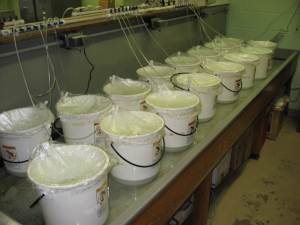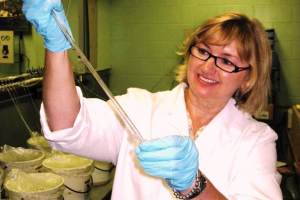Part two of an intermittent series on NOAA Fisheries’ Milford Laboratory, a federal facility that has been a leader in aquaculture research for over 90 years.

A single female oyster can produce millions of eggs in a season, but a vast majority never reaches adulthood in their native environments. Even in shellfish hatcheries, where conditions are under strict control, many oyster larvae succumb to stress or disease. Much of this mortality occurs in the first two weeks; this is the period in oysters’ lives where they are most vulnerable, as they transform from fertilized eggs into free-swimming larvae that finally settle onto some hard surface to begin the next phase of their lives. During this time, the larvae are especially susceptible to both predation and to chemical and biological contamination.
In order to reduce larval mortality, many commercial oyster hatcheries use chemical disinfectants, and in some countries outside the US, antibiotics which can promote the emergence of antibiotic-resistant strains of the pathogens they are trying to eliminate. Because biological contamination in shellfish is bad for both human health and for business, and because so many factors contribute to oyster mortality, shellfish researchers and farmers are always on the lookout for new methods that can improve food safety, promote larval survival and increase crop yields. Scientists at NOAA’s Milford Laboratory appear to have hit on a solution that addresses all of these concerns simultaneously, using naturally-occurring microbes to reduce the spread of pathogens and increase overall survival in oyster larvae.

Diane Kapareiko, a researcher at the Milford Lab, has been working with probiotic bacteria (i.e. bacteria that provide beneficial effects for their host) for the last several years. Kapareiko and her colleagues isolated 26 bacterial strains from oysters and scallops to be tested for their use as potential probiotic candidates. They were tested against a known shellfish-larval pathogenic bacteria of the genus Vibrio, which includes many benign species and some dangerous to shellfish and humans. 16 of these candidates were able to inhibit the growth of this pathogen on agar in Kirby Bauer Disc Diffusion plating trials and were then introduced to oyster larvae to ensure that they didn’t harm the animals.
Eventually one of these strains, dubbed OY15, was selected for further testing based on several favorable characteristics. OY15, which itself is a (non-pathogenic) species of Vibrio, proved not only to effectively inhibit the growth of the test shellfish larval pathogen, but it had no negative impact on either the survival of the oyster larvae or on the growth of the microalgae used to feed those larvae. Perhaps best of all, not only did OY15 improve larval survival when challenged with this pathogen, but it improved overall larval health, without pathogen challenge, by providing early digestion of the microalgal feed, and improving nutrition.
Surprised at their own results, Milford researchers investigated potential reasons for OY15’s success. At first they thought that OY15 was simply outcompeting the harmful bacteria for nutrient resources; after testing that hypothesis unsuccessfully, Kapareiko recounts, “what we found was that OY15 was actually stimulating their immune response, prepping our larvae for a pathogen coming in and, since their immune response is already revved-up from our probiotic, it’s able to respond quicker and better to the pathogen, thus improving survival.”

In late 2014 and 2015, Kapareiko’s team will be collaborating with University of Rhode Island researchers to take OY15 out for field trials, testing it in commercial and academic research hatcheries “to see if it works as well to improve the survival of oyster larvae during the first two weeks of life in the field as well as it did in the laboratory. Once we get past that hurdle, if all is well, it can get commercialized for use in oyster hatcheries.” Kapareiko is optimistic about the prospects for this discovery, adding that “our probiotic can boost survival by 20-35%”, which should translate directly into large increases in marketable oysters for farmers.
Posted by Ken Hamel, Research Intern for CFE Save the Sound
All photo credits: NOAA Fisheries, Milford Laboratory
References:
Lim, H. J., Kapareiko, D., Schott, E. J., Hanif, A., & Wikfors, G. H. (2011). Isolation and evaluation of new probiotic bacteria for use in shellfish hatcheries: I. Isolation and screening for bioactivity. Journal of Shellfish Research, 30(3), 609-615.
Kapareiko, D., Lim, H. J., Schott, E. J., Hanif, A., & Wikfors, G. H. (2011). Isolation and evaluation of new probiotic bacteria for use in shellfish hatcheries: II. Effects of a Vibrio sp. probiotic candidate upon survival of oyster larvae (Crassostrea virginica) in pilot-scale trials. Journal of Shellfish Research, 30(3), 617-625.
